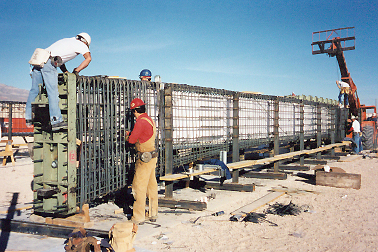Bombardier Innovia Monorail 200 - Anatomy of the Bombardier Beam

The following question and answer session took place between Keith Walls, The Monorail Society Vice-President for Thet
Monorail Society and Carlos A. Banchik, P.E., then-Structural
Design Coordinator for Carter-Burgess in Las Vegas, Nevada during the construction of the Las Vegas Monorail. Carlos was the engineer of record on the original MGM-Bally's Monorail. Many of the questions reflect those that we get from our visitors and Carlos has first hand knowledge of the subject.
Q. What Codes are followed in the design of the Las Vegas Monorail
Project?
A. The guiding document for structural guideway design used in
the Las Vegas Monorail is the American
Concrete Institute document: ACI358.1R-92. Analysis and Design
of Reinforced and Prestressed-Concrete guideway Structures. Then
we use the American Association of State Highway and Transportation
Officials (AASHTO) publication Standard Bridge Design for Highway
Bridges.
Q. What type of loads do you design for in a typical monorail
structure?
A. There are many sets of loads and load combinations required
to ensure the structural capacity of the monorail beam, as it
is a very slender member. Most of the Live Loads are provided
by the vehicle vendor (Bombardier), then "live" loads
due to braking, centrifugal loads, impact, etc. are superimposed
to the "basic live load". Don't forget that there are
many other loads to consider, such as construction loads (post-tensioning
loads) and environmental (temperature, concrete creep and shrinkage,
wind, seismic). The combination of all these loads is provided
in tables contained in the documents outlined above.
Q. What is the distinctive characteristic of a monorail beam when
compared to a regular bridge structure?
A. I would say it is the casting of the beams and the lack of
the ability to adjust the geometry once the beam has been cast
and erected. The monorail beams are what we would consider a mechanical
casting more than a structural casting due to the tolerances required
for proper riding. In your typical bridge structure, there are
slabs cast on top of beams, which we lack in a monorail system.
The importance of the secondary pours or slabs is that the engineers
and the contractors compensate for riding surface unevenness and
the deflections that accompany the construction of any structure.
In a monorail structure, the top and side surfaces are cast at
once and there is no chance to implement much change after the
piece is cast.
Q. Being that the casting tolerances for a beam like the one you
described above are so tight, where are the castings done?
A. The typical cast is done in a set of expensive forms that mirror
the guideway alignment is 120' long section, regardless of the
beam length. When you add the fact that the beams are super-elevated
to improve riding quality, (i.e rotated around the vertical plane)
and that they also contain vertical curves, you have a very complicated
three dimensional geometry that needs to be captured in concrete
and steel. Each beam is approximately 70 Tons in weight, with
7' high ends, 5' in the middle.
Q. How do you erect each beam?
A. The erection is very critical and typically it uses two cranes
to facilitate control over the cast piece. Careful setup on top
of the columns is required to ensure the proper geometry is locked
in placed prior to casting closure pours between the beams. I
encourage your readers to submit any questions they might have
about this technology, I will be glad to respond to them, or research
for the answer. We will provide you with pictures of the actual
construction so you can share them with your readers.
Thank you Carlos!
 / back to Technical Home Page / back to Technical Home Page
|

